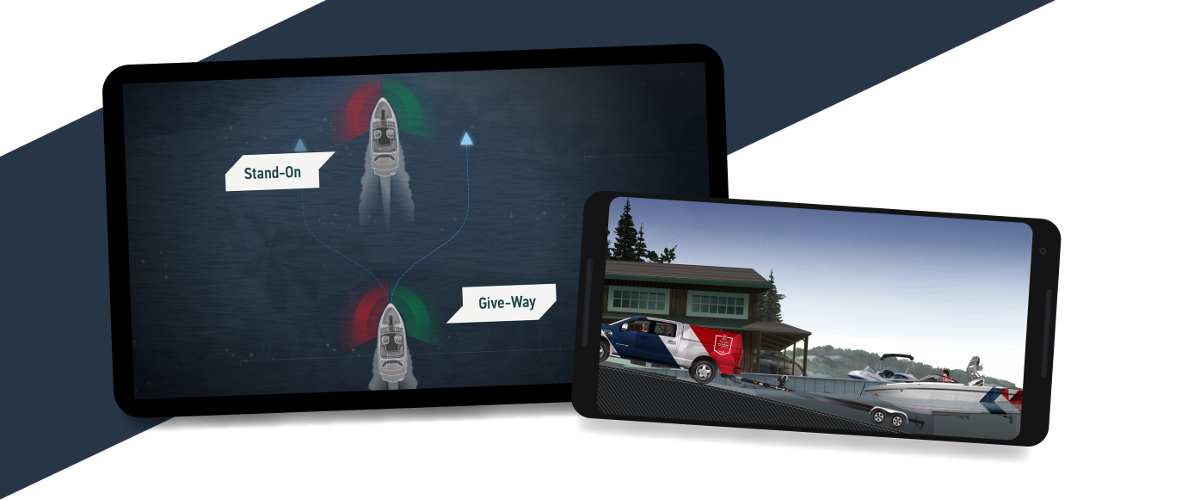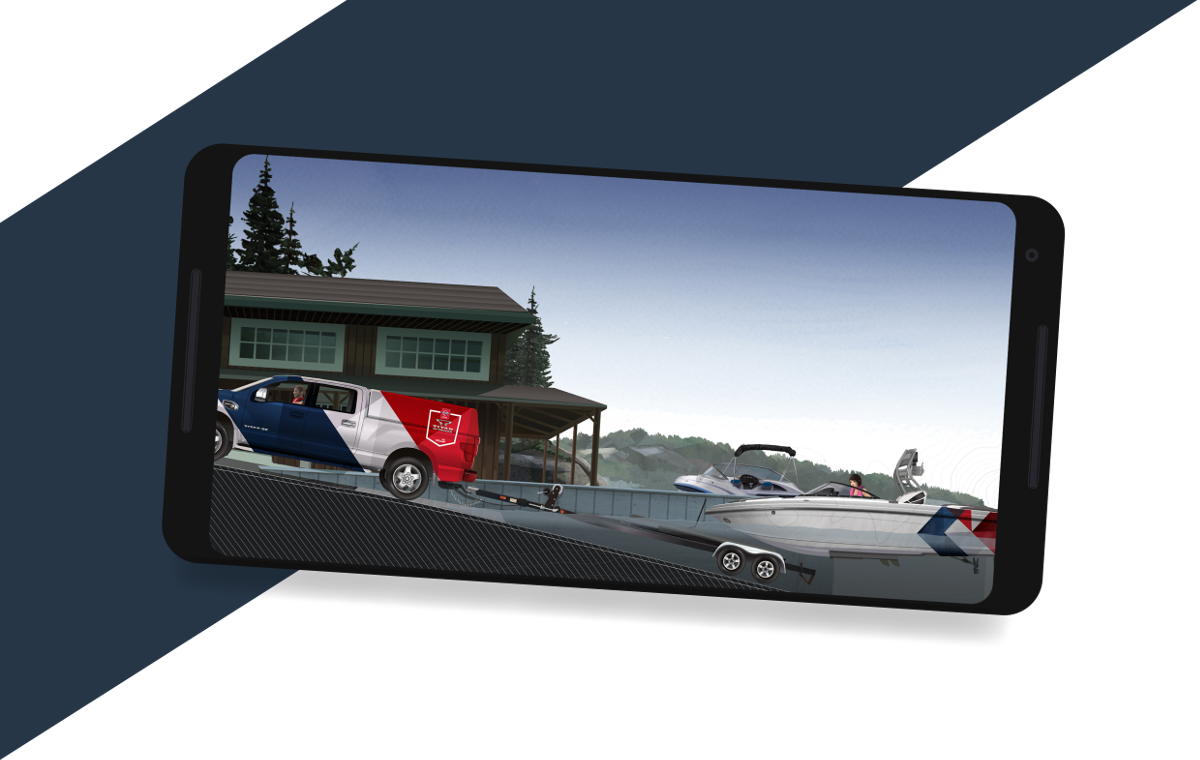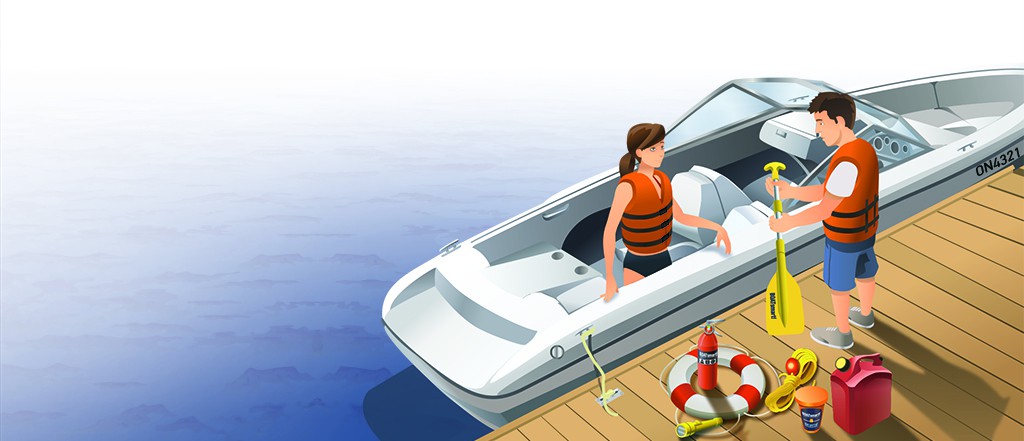Trailering Your Boat
Boat trailering safely isn’t difficult. It’s a matter of choosing the right towing equipment, using common sense when loading and unloading your boat and being confident with the techniques for driving safely with a trailer in tow.
Federal law classifies boat trailers according to the maximum weight they can support when they’re fully loaded with gear, fuel and equipment.
The trailer capacity plate indicates the Gross Vehicle Weight Rating (GVWR) for each class:
- 1: GVWR- 2000 lbs.
- 2: GVWR- 3500 lbs.
- 3: GVWR- 5000 lbs.
- 4: GVWR- 5000 lbs. or more
The Gross Axle Weight Rating (GAWR) can also be found on the trailer capacity plate and indicates the minimum tire rating for the load that the trailer can carry. This means that a heavy-duty load will likely require heavy-duty tires!
Federal law requires your boat trailer to have:
- Current state registration.
- Current state license plates.
- Working trailer lights.
Note: If the boat is more than 8.5 feet wide, it may require a special permit from your state’s Department of Transportation before it can be transported on the highway.
To determine which style of trailer is right for you, consider the following:
- Is the width and length of your trailer suitable for the size of your boat?
- What is the weight capacity of the trailer and is it suitable for the weight of the boat?
- Is the towing capacity of your vehicle suitable for the weight of your boat?
- Do all of the operating lights work properly?
- Are the wheel bearings properly greased and able to operate smoothly?
- Does the coupler (located at the front of the trailer) match the size of your vehicle’s hitch ball?
- Is the trailer equipped with safety chains in case the hitch fails?
- Does your trailer require trailer brakes?
Safe Boating Tip:
Loading, towing and launching your boat safely takes both patience and knowledge. Practice driving and backing up with a loaded trailer in a controlled environment (like an empty parking lot) before you hit the highway.
Trailering Tips:
When driving with a trailer in tow, remember that your vehicle is longer and heavier than it was before the trailer was attached. To trailer a boat safely, you should:
- Drive at a slower speed than normal.
- Allow for greater braking distance.
- Accelerate slowly.
- Turn using a wider radius to allow room for the trailer.
- Use extra caution if driving in high wind, heavy rain, fog or icy conditions.


Get your Official North American
Boating License
The Official NASBLA and Transport Canada Boating Course, Test & License.
Get your Official North American
Boating License
The Official NASBLA and Transport Canada Boating
Course, Test & License.
Towing Your Boat
Tow your boat using the following step by step instructions:
- Before attaching your trailer to the vehicle, make sure that the trailer is properly balanced and level.
- Position the vehicle or trailer so that the hitch ball is directly below the trailer’s coupler, then slowly lower the trailer.
- Securely fasten the tongue coupler and lock the trailer latch using a cotter pin or lock.
- Using tie down straps, securely fasten the boat to the trailer.
- Attach the winch cable and/or winch safety chain to the bow eye of the boat (if so equipped).
- Ensure that the trailer’s safety chains are securely fastened to the hitch. Chains should be long enough to accommodate tight turns but short enough so that the tongue of the trailer cannot touch the road if it becomes dislodged from the hitch.
- Fasten the trailer’s lighting harness to your vehicle.
Launching Your Boat
Launch your boating using the following step by step instructions:
- Make a visual check of the launch area: Is the ramp deep enough to launch your boat? Are there any overhead wires or obstructions?
- Remove the tie-down straps and unplug the trailer lights from your vehicle.
- Ensure the bilge drain plug is in place.
- Place all gear and safety equipment onboard the boat.
- Ensure the winch is connected to the bow of the boat.
- Attach a bow and stern line to the boat.
- Slowly back the trailer into the water until the motor is submerged.
- Test the motor by starting it and allowing it to warm up.
- Shut down the motor and continue backing the trailer into the water until the boat begins to float.
- Use the bow and stern lines to guide the boat off the trailer and then remove the vehicle from the ramp.
Getting ready to set out
If you’re anything like us, and looking to get the best out of your time on the water, it’s all about being prepared. Complete your pre-departure checklist, check the weather, put on your life jacket and get ready to hit the waterways.
Before you take off from the dock, it’s important to consider how you load your boat with both your equipment and the passengers you’ll have onboard. Loading your boat improperly, either by overloading it or by uneven weight distribution, can result in unpredictable boat handling. Here are our tips to help you load your boat accurately.
- Consult your pleasure craft’s compliance notice on your boats hull and ensure that:
- Equipment and people do not exceed the ‘recommended gross load capacity’ of the craft
- The number of people onboard does not exceed ‘the equivalent number of adult persons’ the craft is capable of safely carrying
- Ensure each passenger is wearing a properly fitted and approved PFD or life jacket.
- Be sure that the boat operator boards first and then assists each passenger aboard.
- Position equipment and people on the boat so that weight is equally distributed and as low as possible throughout the watercraft.
- Each person should be properly seated and positioned before the next person comes aboard.
- Check that all equipment is securely fastened and stored properly to prevent uncontrolled shifting once the craft is underway–you should stow gear in lockers that are easily accessible in case of emergency and as low as possible to help stabilize the watercraft.

If you’re a passenger in a boat, there are a few things you should know to be sure you have a safe enjoyable time out on the boat. Keep the following in mind:
- Know the location of the safety equipment onboard
- Read and understand the warning labels on the powerboat before heading out
- Understand that a personal watercraft is less stable than a traditional vessel and that the boat will become more unstable as each passenger boards the craft
- Understand the importance of keeping your weight stable and evenly distributed
- Keep legs and arms within the boat at all times
- Stay away from the boats intake grate while the engine is running – items such as long hair, loose clothing, or PFD straps can become entangled in the moving parts of the jet intake system, resulting in severe injury or death
- Understand that the jet propulsion system is powerful and water and/or debris exiting the jet thrust nozzle can cause severe injury–operators and passengers should avoid being close to the jet thrust nozzle at the rear of the machine
- Never place their feet or legs in the water to aid turning
- Hold onto the seat strap while underway









